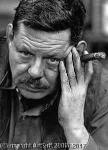David Smith
David Smith
Style: Abstract Expressionism;
Born: 1906
Death: 1965
Biography:
Roland David Smith was an American abstract expressionist sculptor and painter, best known for creating large steel abstract geometric sculptures.
Roland David Smith was born on March 9, 1906 in Decatur, Indiana and moved to Paulding, Ohio in 1921, where he attended high school. From 1924-25, he attended Ohio University in Athens (one year) and the University of Notre Dame, which he left after two weeks because there were no art courses. In between, Smith took a summer job working on the assembly line of an automobile factory. He then briefly studied art and poetry at George Washington University in Washington, D.C.
Moving to New York in 1926, he met Dorothy Dehner (to whom he was married from 1927 to 1952) and, on her advice, joined her painting studies at the Art Students League of New York. Among his teachers were the American painter John Sloan and the Czech modernist painter Jan Matulka, who had studied with Hans Hofmann. Matulka introduced Smith to the work of Picasso, Mondrian, Kandinsky, and the Russian Constructivists. In 1929, Smith met John D. Graham, who later introduced him to the welded-steel sculpture of Pablo Picasso and Julio González.
Smith’s early friendship with painters such as Adolph Gottlieb and Milton Avery was reinforced during the Depression of the 1930s, when he participated in the Works Progress Administration's Federal Art Project in New York. Through the Russian émigré artist John Graham, Smith met avant-garde artists such as Stuart Davis, Arshile Gorky and Willem de Kooning. He also discovered the welded sculptures of Julio González and Picasso, which led to an increasing interest in combining painting and construction.
In the Virgin Islands in 1931–32, Smith made his first sculpture from pieces of coral. In 1932, he installed a forge and anvil in his studio at the farm in Bolton Landing that he and Dehner had bought a few years earlier. Smith started by making three-dimensional objects from wood, wire, coral, soldered metal and other found materials but soon graduated to using an oxyacetylene torch to weld metal heads, which are probably the first welded metal sculptures ever made in the United States. A single work may consist of several materials, differentiated by varied patinas and polychromy.
In 1940, the Smiths distanced themselves from the New York art scene and moved permanently to Bolton Landing near Lake George in Upstate New York. At Bolton Landing, he ran his studio like a factory, stocked with large amounts of raw material. The artist would put his sculptures in what is referred to as an upper and lower field, and sometimes he would put them in rows, "as if they were farm crops".
During World War II, Smith worked as a welder for the American Locomotive Company, Schenectady, NY assembling locomotives and M7 tanks. He taught at Sarah Lawrence College.
After the war, with the additional skills that he had acquired, Smith released his pent-up energy and ideas in a burst of creation between 1945 and 1946. His output soared and he went about perfecting his own, very personal symbolism.
Traditionally, metal sculpture meant bronze casts, which artisans produced using a mold made by the artist. Smith, however, made his sculptures from scratch, welding together pieces of steel and other metals with his torch, in much the same way that a painter applied paint to a canvas; his sculptures are almost always unique works.
Smith, who often said, "I belong with the painters", made sculptures of subjects that had never before been shown in three dimensions. He made sculptural landscapes (e.g. Hudson River Landscape), still life sculptures (e.g. Head as Still Life) and even a sculpture of a page of writing (The Letter). Perhaps his most revolutionary concept was that the only difference between painting and sculpture was the addition of a third dimension; he declared that the sculptor's "conception is as free as a that of the painter. His wealth of response is as great as his draftsmanship."
Smith was awarded the prestigious Guggenheim Fellowship in 1950, which was renewed the following year. Freed from financial constraints, he made more and larger pieces, and for the first time was able to afford to make whole sculptures in stainless steel. He also began his practice of making sculptures in series, the first of which were the Agricolas of 1951-59. He steadily gained recognition, lecturing at universities and participating in symposia. He separated from Dehner in 1950, with divorce in 1952. During his time as a visiting artist at Indiana University, Bloomington, in 1955 and 1956, Smith produced the Forgings, a series of eleven industrially forged steel sculptures. To create the Forgings, he cut, plugged, flattened, pinched and bent each steel bar, later polishing, rusting, painting, lacquering or waxing its surface.
Beginning in the mid-1950s, Smith explored the technique of burnishing his stainless steel sculptures with a sander, a technique that would find its fullest expression in his Cubi series (1961–65). The scale of his works continued to increase—Tanktotem III of 1953 is 7’ tall; Zig I from 1961 is 8’; and 5 Ciarcs from 1963 is almost 13’ tall. Finally, in the late 1950s Smith began using spray paint—then still a new medium—to create stenciled shapes out of negative space, in works closely tied to his late-career turn toward geometric planes and solids.
More...
Wikipedia link: Click Here














